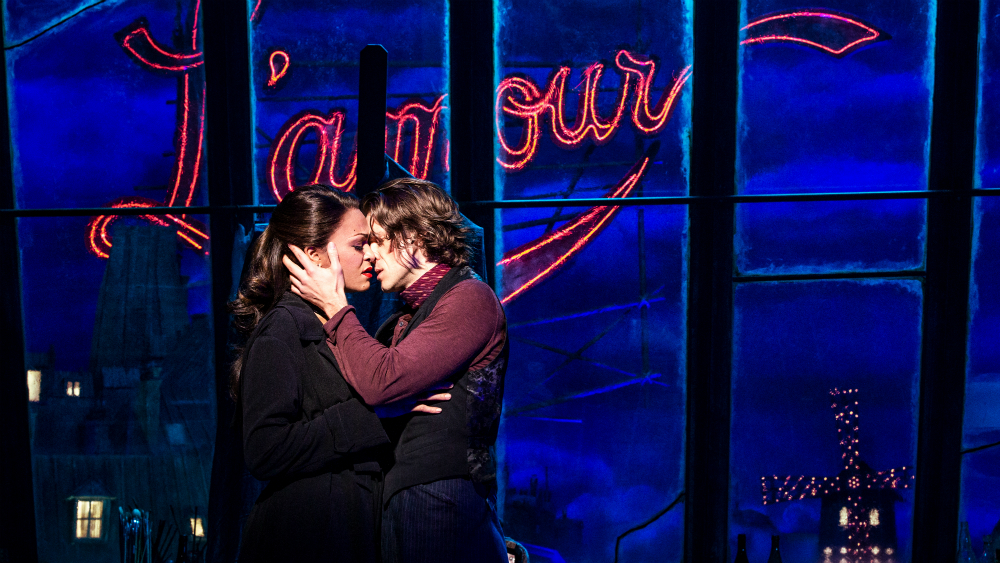Pre-Broadway Review: ‘Moulin Rouge!’
By Bob Verini
LOS ANGELES (Variety.com) – Yes they can-can — they can transform Baz Luhrmann’s 2001 absinthe-tinged fantasia “Moulin Rouge!” into a socko stage spectacular. The story’s been strengthened in this splashy production, while expectations of cinema-inspired visual splendor are met and even exceeded. As for its song score, you can forget about your so-called jukebox shows and their dozen or so standards shoved into a narrative. With 70-odd pop smashes — from Piaf to Perry, from “Lady Marmalade” to Lady Gaga — baked into its dialogue and DNA, “!” has a battery that never runs down. Future prospects on Broadway and beyond, following this brief premiere engagement resuscitating Boston’s venerable Emerson Colonial Theater, seem as rosy-red as the luscious crimson wash poured over the whole business.
The production delivers — does it ever — on Luhrmann and creative partner Catherine Martin’s signature aesthetic, a delirious meld of modern Clubland attitudes and La Belle Epoque revolutionary fervor. With a glittering red windmill spinning above house left and a giant blue elephant rearing over house right, Derek McLane’s set evokes the fabled Montmartre nitery in Valentine’s Day candybox mode, later shifting — with the help of Justin Townsend’s daring, supple lighting effects — into stark film noir on Paris’s mean streets.
Vogueing through it all is an ensemble proudly sporting Catherine Zuber’s period-faithful yet showbiz-heightened costumes as if on a Fashion Week runway, each bustier or tux or gown more audacious than the last. Zuber and director Alex Timbers have deliberately chosen to represent the widest possible range of body types with frank sensuality, making a welcome statement of inclusiveness.
If the visual watchword is tasteful excess, the rhythm of the night is a pulsating backbeat as the cascade of greatest hits works its magic. The show offers a nonstop game of Name That Tune, each familiar vamp eliciting a squeal of recognition, followed by a roar of approval when “Roxanne” or “Firework,” or the scalding act two opener, Lady Gaga’s “Bad Romance,” is performed in full. (The film’s famous “Elephant Love Medley” is revised and expanded for this new edition.) Music supervisor Justin Levine weaves the numbers together with remarkable variety, while choreographer Sonya Tayeh presides over a virtual chronicle of 20th century movement that perhaps only a veteran of eclectic styles on “So You Think You Can Dance” could execute with such confidence.
As for the story, librettist John Logan has fortified the melancholy triangle contrived for the film by Luhrmann and Craig Pearce. Courtesan/headliner Satine (the fierce, phenomenally gifted Karen Olivo) is no passive lily waiting to be consumed by consumption, but a shrewd calculator of percentages in weighing poor but earnest songwriter Christian (dashing Aaron Tveit, injecting the right amount of madness) against the rapacious but well-heeled Duke of Monroth (moody, romantic Tam Mutu). That each man offers a plausible option for Satine invests her choices with greater weight and suspense.
Supporting roles have also been given careful attention. As club entrepreneur Harold Zidler, Danny Burstein is periodically allowed to drop the carnival barker bombast and show us the loneliness and ache within. Particularly satisfying is the metamorphosis of Toulouse-Lautrec (Sahr Ngaujah, so brilliant in “ Fela !”) from the movie’s lisping goofball to a defiant defender of artistic freedom. Ngaujah presents a cane and crabbed walk in place of the painter’s diminutive size, and his backstory, including a hopeless passion for Satine, prompts the show’s single most memorable — and quiet — musical moment, a heartbreaking rendition of “Nature Boy.”
Timbers’ knack for revving up an audience in “ Bloody Bloody Andrew Jackson ” and especially “ Here Lies Love ” is much in evidence here. Although he has sought moments to tighten the springs and bring down the hoopla, more work is to be done if act two isn’t to exhaust cast and spectator alike. (Prime candidate for excision is the too-campy “Green Fairy” fantasy, seemingly inserted because it’s in the film, even though a single absinthe shot would be enough to get Christian out the door to move the plot along.)
Still, you can’t spell “Moulin Rouge! The Musical” without “outrageous,” and creators have got to dance with the extravagance that brung ’em. To their credit, Timbers, Logan and company aren’t just riding on the sensory experience, but are committed to finding the right balance between a story that will engage and move us, and a visual and aural environment that can, and does, blow us away.

